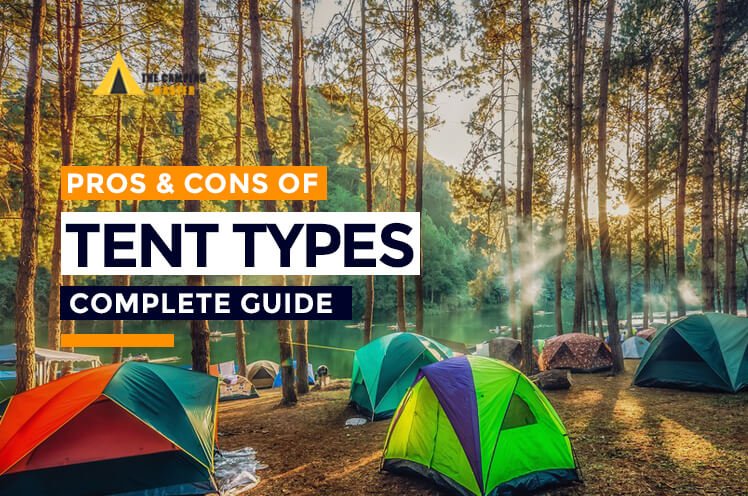Making a guideline for campers on the basics of the pros and cons of all different types of tents for camping is not difficult but tricky. When human beings became “social animals “and felt curious about their security and shelter, the first invention they made was “a tent,” _ the shelter for their loved ones.
Over time, it has been improved thoroughly in the recent century. Nowadays a tent is used only for camping outdoors. Let us draft some main benefits and drawbacks of all types of tents available in the local and international market.
Read More: Different Types of Camping 2024
Different Types of Camping Tents by Needs
There are different types of camping tents available in the market. The description of them is here, along with their benefits and drawbacks.
1- Backpacking Tents

It is a low-weight tent with a sleeping capacity ranging from 2 to 6 persons who want to explore the beauty of the world and stair its scenery. It can pack in a backpack bag easily.
The tent is a 2-walled tent much more robust than one walled domed tent. This tent is commonly used in remote regions with extreme weather and climate changes, even on steep snows and rocks. The best thing about this tent is its lightweight age, greater comfort level, and durability in harsh environments, even in cat and dog rainfall.
There is no suffocation and breathing problem faced by its use. Its structure is built with Ripstop Nylon, Micro mash, bathtub floor, aluminum, and carbon poles with a bigger footprint, making it weather resistant and long-lasting.
Read More: Best Camping Tents Under $100
Pros
- lightweight and available in all sizes
- Easy to carry on a backpack
- Durable in harsh weather
- No breathing problems with it
- A stronger double-walled structure
- Ease in installation.
Cons
- Slightly expensive
2- Car Camping
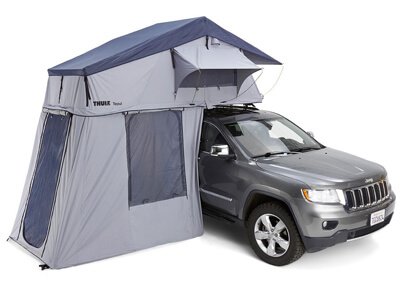
When we discuss the phrase car camping tent ___, the concept that clicks in our mind is to sleep in a car rather than in a tent. It makes sense, but it is a tent crafted to have camped near your vehicle, road, or campsites.
It is a tent at the top or beside your vehicle along with expensive gear that you want to be with you and should be safer when you sleep soundly.
It is not used to have camped in remote areas or rocky hills. The tent is highly rooftop to stand within it. Its interior has a lot of space and can be locked with your vehicle.
Car camping tents also have large windows for ventilation and a transparent screen for looking outside the tent. They are generally waterproof and built with the finest canvas with rain flies but not as sustainable as a backpacking tent, especially in harsh climates and for alpine trips. It is used to have camped in local areas rather than challenging regions.
Pros
- Lightweight
- Easy to carry
- Can be installed on the top roof of the vehicle
- Spacious with maximum sleeping and standing capacity
- No suffocation
- Safety of gears near the campsite
Cons
- Not durable
- Not sustainable in the harsh climate
3. Hammock Tent/ Tree Tent
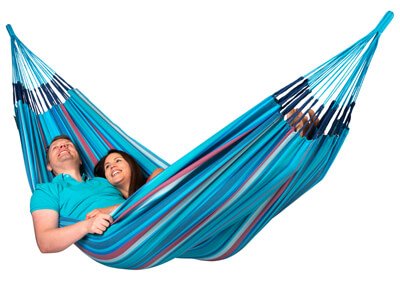
Literary Hammock means abed of canvas or rope mesh elevated from the ground among trees suspended from two supported by a cord at both ends. Precisely it’s a tree-hanging tent. The Hammock is getting popular immensely in recent times. The travelers love it more and dislike sleeping inside a closed tent.
The hammock tents are lightweight and comfortable to carry. It is hung among 2 – 3 or 4 trees during hiking in hilly or mountainous areas.
It is most prevalent in central and South America for catching some Oz while camping. Trees tents are not the same and are essentially traditional backpacking tents strapped to connect among trees.
It has a flat floor to be selected with sleeping pads or gear in the open air. It keeps you cool, dry, and comfortable in forested areas. These portable tents, rain flies, and mosquito nets are also available to protect you from insects or creeping creatures.
You might also like: Best Camping Hammock for Side Sleepers 2022
Read More: Are Hammocks Machine Washable?
Pros
- Set up ease
- Ultralight weight
- Versatile
- Highest comfort level
- It keeps cool, dry & airy
Cons
- Limited sleeping capacity
- No rooms
- No privacy and security
- It can be cold or warm in harsh weather
Read More: How to keep tent dry inside?
4- Family Tent
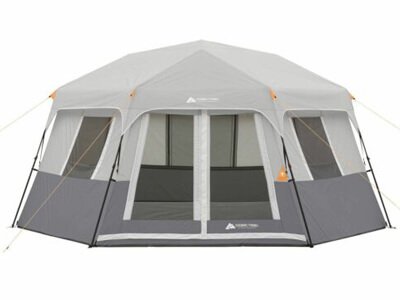
Families or group trips are mostly planned on vacation for enthusiasm to enjoy leisure. These tents are large in width and height. These shelters may contain rooms too.
It is spacious for 10-20 people. Tents are highly top room tents to stand with it. It accommodates a lot of gear and even pets too. In family tourism, children feel it is just like home. These tents have fabric doors, windows, vents, and even LED lighting for night stays and ease. They are pitched during hiking in mountainous and base ground areas.
Pros
- Large capacity to store your gears
- Luxurious
- Best for family and group tours
- Ventilated
- Durable
Cons
- May children get scared due to its size
5- Glamping / Luxurious Tents
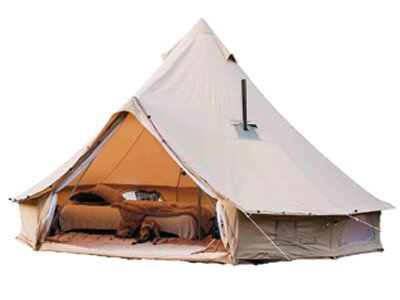
It is a form of camping associated with all types of luxurious facilities compared to traditional ones. It is perfect for those city slickers who seek a glance of nature without letting down all luxuries of life.
Precisely glamping means “glamour.”
These tents are crafted with all necessities and modern conveniences such as; ample interior, preparing food, water filters, electricity, internet access, cabins, pools, heated tents, large windows and doors, top gear, and storage to maintain high morale among campers.
These accommodations are just like a bungalow. These tents are warmly liked by new campers but discouraged by professionals as they reduce skilled development, i.e., learning first aid and CPR, pitching tents choosing campsites during outdoor stays.
Pros
- Highest comfort level
- Best for permanent outdoor stay
- All luxuries of life
- Outstanding for family or group Camping
- Maximum relaxation and safety
Cons
- It is less intimidating as it reduces bonding with nature
- Reduces skill development
6- Mountaineering Tents
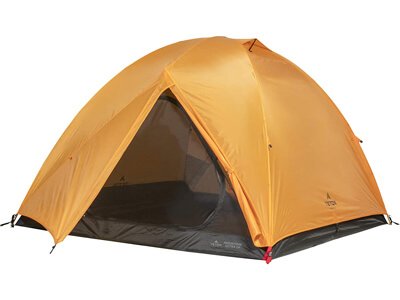
Mountain tents are the modified form of backpacking tents crafted for alpine expeditions in challenging terrains.
The campers who adopt expeditious terrains and explore the world in harsh weather prefer to have these tents due to their specific model. These tents are designed in single-wall with thicker material, more robust footprints, aluminum poles, extra-strong micro mesh, lagers door coverage (vestibules), sustainability in the wind, and rain essential store gear for hiking. These tents are also insulated to stay in snow falling. It is available for 2-4 persons in different designs and shapes. It is usually cumbersome compared to backpacking or car-camping tents with limited sleeping capacity.
Pros
- Durable in challenging terrain
- Thicker material
- Larger vestibules
- Single-walled
- Well-insulted
Cons
- Heavier
- Costly
7- Three-Season Tent / Summer Tents

The term “three-season tent refers to withstanding in normal snow-free climate conditions above freezing surrounding; regular rain, the wind blowing slightest hailing, summers and winters expect snowfall, bombarded hail, storms, hurricanes, etc.
These tents cannot be used in harsh terrains. However, seasons vary according to the camping region, so keep in the notice the weather condition of the campsite.
These tents are crafted on the concept of backpacking tents with ultra-lightweight aluminum poles and traditional micro-mesh fabrics along with vents, windows, and rain-fly inner canopies from mesh.
Due to their traditional manufacturing, these tents cannot bear harsh climate conditions. They are best in warmer months of the year. In certain situations, three-season tents can be used in winter through insulation. To insulate these tents, minimize ventilated areas, waterproofing, and use winter-specific stakes, replace tent poles.
Pros
- Ultra weight
- Easy to backpacking
- Cheaper spacious
- Pop-up design to be set up in seconds
- Versatile
Cons
- Not suitable in hash conditions
- The lowest level of insulations
- Can cause havoc
8- Four Season Tent / Winter Tent
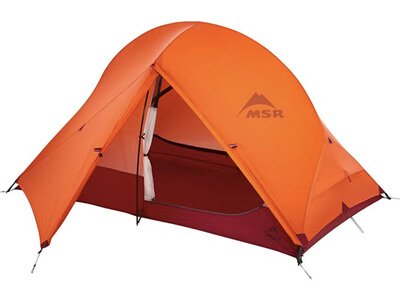
Four-season tents can be termed winter tents as it is specifically designed for cold weather, snowfall, or winters. The campers used these tents in harsh climates and remote regions, offering more protection than summer tents.
The best part of these tents is durability and weather resistance. They stood griped in foul weather as they are built with thicker rips top fabric rather than mesh stronger poles and stakes.
These are waterproof, highly instated to resist extreme weather, rainfall, and insulated floor tub which protects the camper from drastic geological changes. These four seasons tents are heavier and cannot be backpacked, counterparts to 3-season tents on rough terrains.
Pros
- Durable due to more robust fabric
- Stronger by high-quality poles and stakes
- Protection from extreme weather
- It can be used in all seasons
Cons
- Due to its more robust structure, it is heavier
- Highly expensive
- Not versatile
9- Canvas Tent
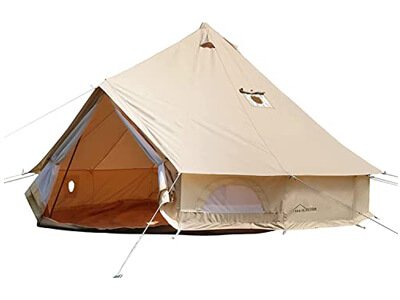
These tents are built up with thick cotton or synthetic materials. They are fantastic miracle fabric that keeps the camper cool in summer and warmer in winter as the heat remains inside. It has been used for recreational, hunting, and military expeditions too. However, these tents are expensive but save money in the long run due to their longevity decades as polyester sustained over 500 years.
You might also like: Best Canvas Tents for Camping 2023
Canvas tents have more significant temperature regulations, which make them glamping. It is breathable and provides less sun exposure. These tents are available in all sizes, even up to 13 feet, with a maximum capacity for persons and hear in which you plan to sleep for an extended weekend trip. These tents take enough time to set up due to their heaviness. The main feature is durability, weather resistance, and biodegradability, which create smugness in its users.
Read More: How To Patch A Canvas Tent?
Pros
- Durable and beneficial in extended run usage
- Not affected by diversity in temperature
- Can bear drastic changing in climate
- No breathing problems
- Good condensations
- Weather resistant
Cons
- Heavier
- Expensive
Read More: Which one is better? Canvas Tent or Nylon Tent?
Different Types of Tents for Camping by Shape
For a camper, the essential factor regarding tent buying is its size, material cost, and shape. Let’s have a glance at specific conditions and their benefits.
10- A frame / Ridge / Triangular Tent
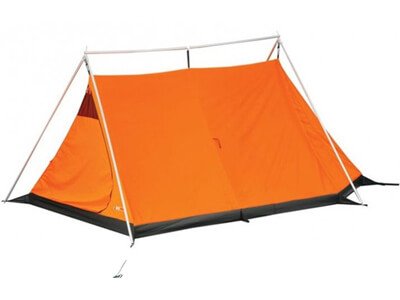
As the header speaks, its diminutions are triangular, single frame with tracking cross poles stretching across the length of tents accompanied with one sheet trap or canvas which holds up the roof. It has no bars, yet they are incredibly sturdy and stable.
Frame tents are ideal for solo or two-person accommodation with a limited gear capacity. These tents sometimes have a canopy and rainfly with sloped roofs to make them waterproof. Solo camper loves it as it is budget-friendly. But when you try to stuff it with more people and gear, this becomes unfriendly for its limited head top, triangular shape. It is not ideal for families or groups. Despite their design, they are heavier and bulky—-not suitable for backpack hiking.
Pros
- A great choice for a solo camping
- Protection of elements / gear
- Sturdy and sustainable setup
- Ease in set up
- Budget Friendly
Cons
- Heavier and bulky
- Limited accommodation capacity
11- Dome Tent
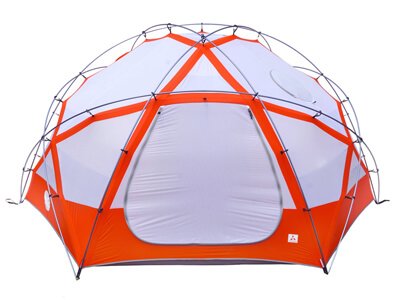
Dome means “a hemispherical roof of the structure .”Literary a dome tent is a hemispherical rooftop tent with a rectangular floor, bound with 2-3 crisscrossing poles stretching to the ground with zero stakes or guylines. It is a popular tent shape because of its flexibility, low weight, the alternative of a backpacking tent with a larger head space to stand within it, and maximum habitable space with small vestibules. Its sleeping capacity is 2 to 6 people. Hackers love its convenience of setting up and high performance even in the wind blowing and sudden climate changes.
But these tents are not sustainable in storms and may be blown away and flattened due to their light weightage.
They are not ideal for family camping.
Pros
- Sturdy and low-weight
- Easy setup
- Budget-friendly
- Maximum comfort level
Cons
- Not durable in harsh weather
- Not ideal for a family trip
12- Tunnel Tent
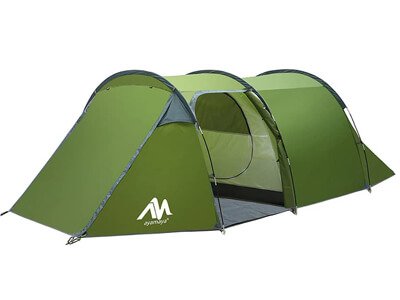
It is a cylindrical, tube shape tent in a caterpillar resemblance with curved flexible, multiple & parallel poles tied with fabric by lines to the ground.
The group campers prefer the tunnel tent for its wind resistance, illumination quality, and good sleeping and gear storage, as multiple rooms can comfortably provide up to 6 persons.
There is a head-ease to stand within it. But the worst thing about this kind of tunnel is its sagging issue as the abidance of water can be collected in the middle of the tent’s roof. But in general, these tents are ideal for group camping and budget saving.
Different types of tunnel tents are available in the market. Some are with soft, flexible poles, while others have rigid-flexible rods erected in parallel patterns.
Making it time for pitching, if campers want to curtail cost and not compromise on durability in four weather, they will defiantly choose tunnel tents.
Pros
- Spacious ideal for a group hiking
- Sturdy against wind
- Illuminating and airy
Cons
- Heavy, costly, time consumer
13- Geodesic Tents
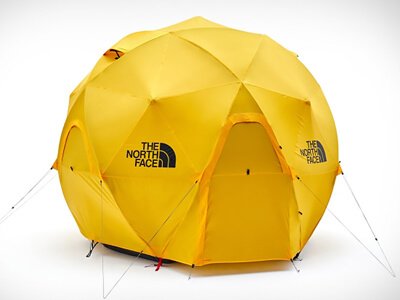
Geodesic means geometrical shape, the shortest possible line between two points on a curved (semi-spherical) or plane surface. So geodesic tents are the next level of a dome tent with multiple crossbars up to 5 or more tied with creating triangles and hexagons which distribute pressure across the structure.
It gives additional strength to stand against winds and harsh climates. The multiple anchor points provide space for extra headroom and comfort. As its system is mathematical, its pitching is complicated and time-consuming. Geodesic tents are bulky, heavy, and expensive because of additional poles. These tents are extraordinarily sturdy against wind pressure created on big mountains and provide maximum protection in bad weather. As they are spacious, a lot of habitable gear can be stuffed in them, and enough sleeping and standing capacity.
Pros
- Multiples head rooms
- Sturdy in bad weather
- Ideal for mountains Camping
Cons
- Bulky and heavier
- Costly
- Different to pitch
14- Instant / Pop Up Tent
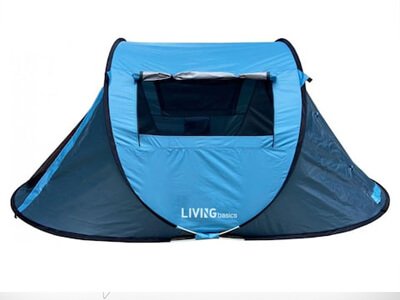
A pop-up (instant) tent refers to a headache-free setup in a blink of an eye. These tents are crafted with pre-attached pole stakes; rainfall to design in 5 to 3.5 seconds, depending on the size. Pop-up tents are ideal for beginners and kids camping in backyards, beachside, rooms, or plain areas but not in mountainous regions. Its height varies from more minor to bigger up to 4000 pounds.
Pop-up tents require com with spring-coiled attachments. Its packing much practice for packing as they time maybe 2.5 to 5 minutes. Instant tents are not sturdy poles. The sleeping capacity is 2-4 persons. The life span of the pop-up tent is shorter and challenging to repair if broken. Compared to backpacking or dome tents, they are not ideal for the harsh wind blowing or heavy rains.
Read More: How to Increase Space In A Pop-Up Camper?
Pros
- Eye-blink time setup
- Lightweight
- Suitable for kids or beginners camping
- Pre-attached structure
Cons
- Shorter life span
- Not ideal for harsh climate
15- Cabinet Tent
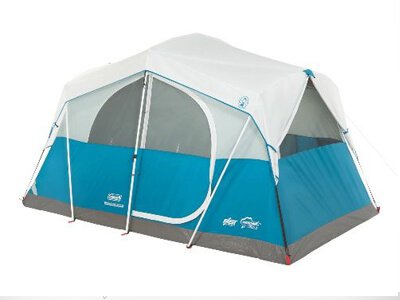
Cabin tents are the next improved level of the family tent pop-up style. It is a tent with multiple headroom and separate dividers established by fabric and vertical aluminium poles.
It is ideal for car-camping and group camping as it generates enough space for every camper to live in a separate room. It is available in an instant style structure with thinner poles and vertical headrooms.
But the worst thing about this tent is its non-resistance against storms and weather as its high roof flattens and may be pooled up with water in rains.
Its bulky size makes it difficult to pack as compared to other tents. It is primarily unrepairable due to low-quality material and pre-attached structure, as in a pop-up tent.
Pros
- Ideal for family or group camping
- Spacious
- Good for ideal weather
Cons
- Bulky
- Costly
- Difficult repair
16- Pyramid Tent
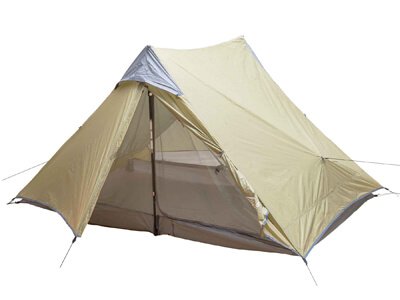
It is another form of a triangular tent. A pyramid tent is a 3D triangular structure creating a square base and sloping down triangular with a central point.
A pyramid tent is a fabric structure holding a single pole at the center, with guylines on the sides. It is airy and illuminating but sustainable against winds even if snow falls if pitched at correct angles. They are uncomfortable for multiple people due to the lack of headroom and limited space for gear.
It is ideal for solo or 2-3 persons camping even in rough terrains. Pyramid tents are ultra-light like backpacking or ridge tents but more sustainable than in harsh weather. These tents are not ideal for group camping. In the past pyramid, tents were provided with wooden poles but now aluminum ones.
Pros
- Ideal for a solo camping
- Ultra-light
- Versatile
- Weather resistance
Cons
- No headspace
- Maybe it flattens if not erected correctly
Different Types of Tents for Camping by Specialty
As described above, a series of tents contain unique features and qualities. Now some are precisely hereunder with extraordinary crafted features.
17- Multi-room / Vis-à-vis Tent
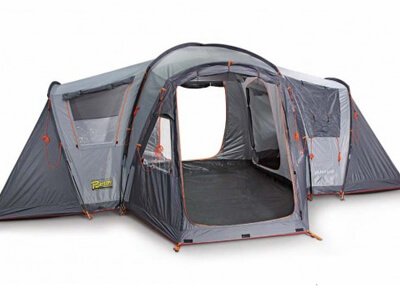
Vis-à-vis is a French terminology that means face to face. So vis-à-vis tents are next level to glamming tents providing multiple rooms, i.e., main bedroom, guest room, children room, garage facing each other with separate entrances to ensure privacy to every camper.
Its sleeping capacity ranges from 8-20 people—–ideal for a family car camping with all luxuries of life. These accommodations comprise huge structure building which requires more people to set up.
A time consumer, the worst thing about these tents is that they are not sustainable in foul weather due to low air-pressure resistance. Still, they are an excellent performer for more prominent family or group camping on sunny days.
Pros
- Multiple rooms for separate living
- Huge people in-habitat capacity
- Secure and crave privacy
Cons
- Very bulky
- Costly
- Not a good performer against wind
18- Inflatable Tent / Air Tents

Inflatable means a tent that doesn’t be flattened except punched. An inflatable tent comprises an air tube rather than metallic or plastic poles to build this structure. You require an air pump, either electrical or manual, to pop up this kind of tent, you to stretch the corners and inset air. The tent will stand for 10 seconds and be ready for chronic use. It is convenient to have an inflatable tent for beginners or kid-camping. It is heavier and bulky but easy to set up. The worst thing about this tent is that if punched, it will be flattened forever but not explode.
Pros
- Instant setup
- No metallic or plastic poles
- Tube shape structure
- Great performer
- Ideal for kids-camping
Cons
- Heavier
- Costly
- Requires electricity or foot-pumping
19- Bell Tents / Tipi Tents

The rounded/circular shape tents provide a tipi at the roof to let the smoke out of the tent and regulate temperature. These tents are crafted with heavy canvas steel poles, mesh windows and doors. The unique feature of bell tents is the wood stove—-necessity of the winters. These tents are upgraded forms of ridge tents, but some parts are similar to glamping tents. As there is a central steel pole with additional side poles opening into a canopy, a circular shape provides a huge space for many people to sleep in but is heavier and more complicated to set up. Not ideal for backpacking and traditional camping.
Pros
- Best for winters as a wood-stone provider
- Comfortable for many people
- Versatile
Cons
- Heavier and rigid
- Costly
- Complicated setup due to steel poles
20- Traps and Bivy Sacks
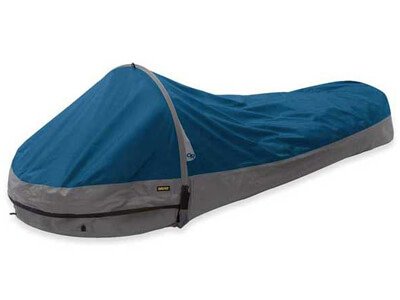
Traps are similar to hummock tents. It is a thin canvas sheet with no poles, floor, and side wall but with guidelines or supports to be set up in trees or other configurations. Mountaineers love it for solo camping on biking, snow cave, or big-wall routes with minimal gears on the backpack. But it is featured with no protection in harsh weather, direct exposure to nature, and no equipment safety.
Bivy sacks are a bag for solo-sleeper with no poles. A hiker with minimal gear sleeps inside the sack, opening holes on the face. But many campers feel suffocated in the bag, so now bivy bags have come up with trekking poles to keep the fabric away from the beginning. The traps and bivy sack are ideal for solo/emergency protection during prolonged nighttime stays in foul weather due to their lightweight and effortless setup.
Pros
- Ultra-lightweight
- ideal for a solo camping
- Versatile for many configurations
- Budget-friendly
Cons
- Less protection
- No ideal for drastic weather changing
21- Roof Top Tent

Roof top tent means to habitat on the roof of your vehicle with no headache of installation of the tent on the campsite.
Campers need a ladder to climb their truck to get in the tent. But depending upon the size of the car, the sleeping capacity may vary up to 2-4 people. The tents are built with canvas and need only luggage barriers on the top roof of the car to make a camp base.
These tents are primarily used for camping in Jungles of African Safari or North America and Australia, where snakes, bears, wolves, leopards, and lions dislike human activities. Roof top tents provide maximum security to camper and foodstuff gear as tents can be locked with vehicles. The downside of these habitats is the availability of a vehicle with bars. It can cause damage to the car too. But the best protection against a predator is fantastic.
Pros
- Security against beasts
- Easy to build up
Cons
- Require a vehicle with luggage bars
- Can cause damage to the vehicle
- Expensive
22- Hot Tents
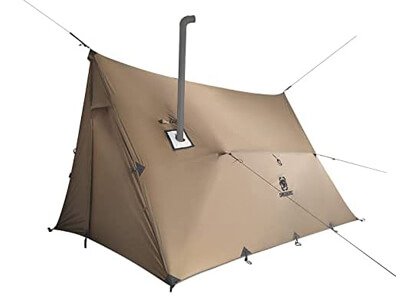
Hot tents refer to the fire burning in heavy snowfall areas and harsh winter to keep the campers warmer and secure. Hot tents are crafted with heavy fireproof canvas along with a chimney to allow the smoke to blow away out of the tents.
The campers can cook food in these tents and burn wood in cold weather. Hot tents are usually heavier and cannot be backpacked; instead needs a sled to carry on rough terrains and forest but are easy to haul on snow and plains.
As the chimneys are provided, the campers face no suffocation and breathing problem during wood burning. The downside of these tents is that they can only be used in winters and harsh climates.
Pros
- Warmer in harsh weather
- Superb weather resistant
- Fireproof
Cons
- Heavy
- Difficult to setup
Precautions Regarding Tents
Here I list queries regarding tenting and precautions related to tent buying for the first time.
Quires:
A camper or a buyer should analyze some crucial aspects while going camping
- How much the number of people and their gear amounts
- Selecting the campsite location
- Budget factor
- Habitat packed weightage
- Weather conditions of the campsite
Precautions:
While camping, a buyer should take some precautions regarding buying and tenting.
1. Don’t ignore the strength of the people who will be habitat in camp. Avoid over-crowding, which may lead to suffocation and discomfort in sleeping.
2. A hiker should take measures to pack gear and foodstuff. As more weightage leads to the difficulty of carriage and setup
3. While buying a tent, a buyer should check the vents, doors, material quality, and shape of the tent so that he may not suffer from any difficulty during camping.
Final Thoughts: Types of Camping Tents
Here I tried at my best strength to make awarethe ness of pros and cons of all different types of camping tents. A numerous list is provided above with technicalities and drawbacks. Still, I now leave the whole on the shoulder of the buyer to consider it, which is far best for him and his buddies while having fun and activities on the campsite. Hope for the best.
You Might Also Like:

